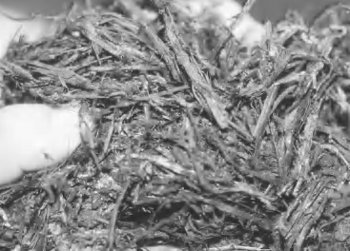Phase II: Finishing the Compost
Phase II composting is the second step of compost substrate preparation. The first objective of Phase II is to pasteurize the composted substrate. The composted substrate is pasteurized to reduce or eliminate the bad microbes such as insects, other fungi, and bacteria. This is not a complete sterilization but a selective killing of pests that will compete for food or directly attack the mushroom. At the same time, this process minimizes the loss of good microbes.
The second goal of Phase II is to complete the composting process. Completing the composting process means eliminating all remaining simple soluble sugars and gaseous and soluble ammonia created during Phase I composting. Since ammonia is toxic to the mushroom mycelium, it must be converted to food the mushroom can use. The good microbes in Phase II convert toxic ammonia in solution and amine (other readily available nitrogen compounds) substances into protein—specific food for the mushroom. At the end of Phase II, volatile ammonia (concentration more than 0.05 percent) will inhibit mushroom spawn growth. Generally, ammonia concentrations above 0.10 percent can
be easily detected by a person and are toxic to the spawn. Most of this conversion of ammonia and carbohydrates is accomplished by the growth of the microbes in the compost. These microbes are very efficient in using Phase I composting products, such as ammonia, as one of their main sources of food. The ammonia is incorporated as mostly protein into their bodies or cells. Eventually the mushroom uses these packets of nutrients as food.
Phase II objectives are possibly the most difficult procedures in growing mushrooms. Because of a composting or other cultural problem, growers sometimes have to adjust Phase II programs. The Phase II process takes anywhere from 7 to 18 days, depending on how the air and compost temperatures are managed to control microbial activity.
During Phase II in standard bed or tray systems, compost temperatures are brought down through all temperature ranges to ensure that all the different species have a chance to convert their specific source of carbohydrates. The composted substrate throughout Phase II should appear to have moderate «firefang»—a term referring to the white-flecking microbial growth pattern of the thermophilic microorganism (Figure 9).

Figure 9. Handful of composted substrate showing the white-flecking ( «firefang») microbial growth.
Pasteurization (peak heat, boost) should be completed toward the start of Phase II. Effective pasteurization will eradicate harmful bacteria, nematodes, insects, and fungi. In general, air and composted substrate temperatures should be raised together to 140ºF (60ºC) for at least 2 hours. Growers make several compromises to this range, but it is a time-temperature relationship.
The good microbes grow best at temperatures from 115ºF to 140ºF; the more ammonia-utilizing microbes grow best in the temperature range of 120–128ºF (47–49ºC). The longer the microbes in the composted substrate remain in this optimum range with all the critical growth requirements available, the faster the ammonia will be converted. Understanding how these microbes grow and work in composted substrate should make the management of Phase II a little easier. The process of going through this temperature range will produce the most protein or the maximum amount of food for the mushroom. A good rule of thumb is not to drop the composted substrate temperature more than 5ºF per 24 hours, which maintains the compost substrate in the desired range for about 4 or more days.
5205 view.